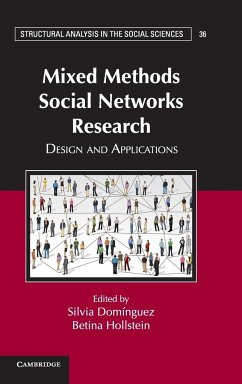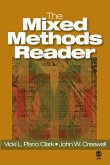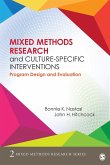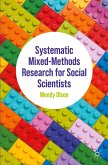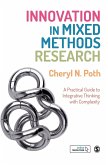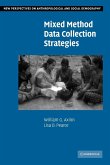Mixed Methods Social Networks Research
Herausgeber: Domínguez, Silvia; Hollstein, Betina
Mixed Methods Social Networks Research
Herausgeber: Domínguez, Silvia; Hollstein, Betina
- Gebundenes Buch
- Merkliste
- Auf die Merkliste
- Bewerten Bewerten
- Teilen
- Produkt teilen
- Produkterinnerung
- Produkterinnerung
This volume demonstrates the potential of mixed-methods designs for researching social networks and the utilization of social networks for other research.
Andere Kunden interessierten sich auch für
![SAGE Handbook of Mixed Methods in Social & Behavioral Research SAGE Handbook of Mixed Methods in Social & Behavioral Research]() Abbas TashakkoriSAGE Handbook of Mixed Methods in Social & Behavioral Research184,99 €
Abbas TashakkoriSAGE Handbook of Mixed Methods in Social & Behavioral Research184,99 €![Advances in Mixed Methods Research Advances in Mixed Methods Research]() Advances in Mixed Methods Research81,99 €
Advances in Mixed Methods Research81,99 €![The Mixed Methods Reader The Mixed Methods Reader]() Vicki L. Plano ClarkThe Mixed Methods Reader160,99 €
Vicki L. Plano ClarkThe Mixed Methods Reader160,99 €![Mixed Methods Research and Culture-Specific Interventions Mixed Methods Research and Culture-Specific Interventions]() Bonnie K. NastasiMixed Methods Research and Culture-Specific Interventions73,99 €
Bonnie K. NastasiMixed Methods Research and Culture-Specific Interventions73,99 €![Systematic Mixed-Methods Research for Social Scientists Systematic Mixed-Methods Research for Social Scientists]() Wendy OlsenSystematic Mixed-Methods Research for Social Scientists30,99 €
Wendy OlsenSystematic Mixed-Methods Research for Social Scientists30,99 €![Innovation in Mixed Methods Research Innovation in Mixed Methods Research]() Cheryl N. PothInnovation in Mixed Methods Research115,99 €
Cheryl N. PothInnovation in Mixed Methods Research115,99 €![Mixed Method Data Collection Strategies Mixed Method Data Collection Strategies]() William G. AxinnMixed Method Data Collection Strategies41,99 €
William G. AxinnMixed Method Data Collection Strategies41,99 €-
-
-
This volume demonstrates the potential of mixed-methods designs for researching social networks and the utilization of social networks for other research.
Hinweis: Dieser Artikel kann nur an eine deutsche Lieferadresse ausgeliefert werden.
Hinweis: Dieser Artikel kann nur an eine deutsche Lieferadresse ausgeliefert werden.
Produktdetails
- Produktdetails
- Verlag: Cambridge University Press
- Seitenzahl: 406
- Erscheinungstermin: 16. Februar 2016
- Englisch
- Abmessung: 235mm x 157mm x 26mm
- Gewicht: 736g
- ISBN-13: 9781107027923
- ISBN-10: 1107027926
- Artikelnr.: 41025151
- Herstellerkennzeichnung
- Libri GmbH
- Europaallee 1
- 36244 Bad Hersfeld
- gpsr@libri.de
- Verlag: Cambridge University Press
- Seitenzahl: 406
- Erscheinungstermin: 16. Februar 2016
- Englisch
- Abmessung: 235mm x 157mm x 26mm
- Gewicht: 736g
- ISBN-13: 9781107027923
- ISBN-10: 1107027926
- Artikelnr.: 41025151
- Herstellerkennzeichnung
- Libri GmbH
- Europaallee 1
- 36244 Bad Hersfeld
- gpsr@libri.de
Part I. General Issues: 1. Mixed methods social network research: an
introduction Betina Hollstein; 2. Social network research Peter J.
Carrington; 3. Triangulation and validity of network data Andreas Wald; 4.
A network analytical four-level concept for an interpretation of social
interaction in terms of structure and agency Roger Häussling; Part II.
Mixed Methods Applications: 5. Social networks, social influence, and
fertility in Germany: challenges and benefits of applying a parallel mixed
methods design Laura Bernardi, Sylvia Keim and Andreas Klärner; 6. Two
sides of the same coin: the integration of personal network analysis with
ethnographic and psychometric strategies in the study of acculturation
Isidro Maya Jariego and Silvia Dominguez; 7. Adaptation to new legal
procedures in rural China: integrating survey and ethnographic data
Christine Avernius and Jeffrey C. Johnson; 8. Mixing ethnography and
information technology data mining to visualize innovation networks in
global networked organizations Julia Gluesing, Kenneth Riopelle and James
A. Danowski; Part III. New Methodological Approaches Used in Mixed Methods
Designs: 9. Fuzzy set analysis of network data as mixed method personal
networks and the transition from school to work Betina Hollstein and
Claudius Wagemann; 10. Reconstructing social networks through text
analysis: from text networks to narrative actor networks Joan Miquel Verd
and Carlos Lozares; 11. Give meaning to social networks: methodology for
conducting and analyzing interviews based on personal network
visualizations José Luis Molina, Isidro Maya Jariego and Christopher
McCarty; 12. Simulating the social networks and interactions of poor
immigrants Bruce Rogers and Cecilia Menjívar.
introduction Betina Hollstein; 2. Social network research Peter J.
Carrington; 3. Triangulation and validity of network data Andreas Wald; 4.
A network analytical four-level concept for an interpretation of social
interaction in terms of structure and agency Roger Häussling; Part II.
Mixed Methods Applications: 5. Social networks, social influence, and
fertility in Germany: challenges and benefits of applying a parallel mixed
methods design Laura Bernardi, Sylvia Keim and Andreas Klärner; 6. Two
sides of the same coin: the integration of personal network analysis with
ethnographic and psychometric strategies in the study of acculturation
Isidro Maya Jariego and Silvia Dominguez; 7. Adaptation to new legal
procedures in rural China: integrating survey and ethnographic data
Christine Avernius and Jeffrey C. Johnson; 8. Mixing ethnography and
information technology data mining to visualize innovation networks in
global networked organizations Julia Gluesing, Kenneth Riopelle and James
A. Danowski; Part III. New Methodological Approaches Used in Mixed Methods
Designs: 9. Fuzzy set analysis of network data as mixed method personal
networks and the transition from school to work Betina Hollstein and
Claudius Wagemann; 10. Reconstructing social networks through text
analysis: from text networks to narrative actor networks Joan Miquel Verd
and Carlos Lozares; 11. Give meaning to social networks: methodology for
conducting and analyzing interviews based on personal network
visualizations José Luis Molina, Isidro Maya Jariego and Christopher
McCarty; 12. Simulating the social networks and interactions of poor
immigrants Bruce Rogers and Cecilia Menjívar.
Part I. General Issues: 1. Mixed methods social network research: an
introduction Betina Hollstein; 2. Social network research Peter J.
Carrington; 3. Triangulation and validity of network data Andreas Wald; 4.
A network analytical four-level concept for an interpretation of social
interaction in terms of structure and agency Roger Häussling; Part II.
Mixed Methods Applications: 5. Social networks, social influence, and
fertility in Germany: challenges and benefits of applying a parallel mixed
methods design Laura Bernardi, Sylvia Keim and Andreas Klärner; 6. Two
sides of the same coin: the integration of personal network analysis with
ethnographic and psychometric strategies in the study of acculturation
Isidro Maya Jariego and Silvia Dominguez; 7. Adaptation to new legal
procedures in rural China: integrating survey and ethnographic data
Christine Avernius and Jeffrey C. Johnson; 8. Mixing ethnography and
information technology data mining to visualize innovation networks in
global networked organizations Julia Gluesing, Kenneth Riopelle and James
A. Danowski; Part III. New Methodological Approaches Used in Mixed Methods
Designs: 9. Fuzzy set analysis of network data as mixed method personal
networks and the transition from school to work Betina Hollstein and
Claudius Wagemann; 10. Reconstructing social networks through text
analysis: from text networks to narrative actor networks Joan Miquel Verd
and Carlos Lozares; 11. Give meaning to social networks: methodology for
conducting and analyzing interviews based on personal network
visualizations José Luis Molina, Isidro Maya Jariego and Christopher
McCarty; 12. Simulating the social networks and interactions of poor
immigrants Bruce Rogers and Cecilia Menjívar.
introduction Betina Hollstein; 2. Social network research Peter J.
Carrington; 3. Triangulation and validity of network data Andreas Wald; 4.
A network analytical four-level concept for an interpretation of social
interaction in terms of structure and agency Roger Häussling; Part II.
Mixed Methods Applications: 5. Social networks, social influence, and
fertility in Germany: challenges and benefits of applying a parallel mixed
methods design Laura Bernardi, Sylvia Keim and Andreas Klärner; 6. Two
sides of the same coin: the integration of personal network analysis with
ethnographic and psychometric strategies in the study of acculturation
Isidro Maya Jariego and Silvia Dominguez; 7. Adaptation to new legal
procedures in rural China: integrating survey and ethnographic data
Christine Avernius and Jeffrey C. Johnson; 8. Mixing ethnography and
information technology data mining to visualize innovation networks in
global networked organizations Julia Gluesing, Kenneth Riopelle and James
A. Danowski; Part III. New Methodological Approaches Used in Mixed Methods
Designs: 9. Fuzzy set analysis of network data as mixed method personal
networks and the transition from school to work Betina Hollstein and
Claudius Wagemann; 10. Reconstructing social networks through text
analysis: from text networks to narrative actor networks Joan Miquel Verd
and Carlos Lozares; 11. Give meaning to social networks: methodology for
conducting and analyzing interviews based on personal network
visualizations José Luis Molina, Isidro Maya Jariego and Christopher
McCarty; 12. Simulating the social networks and interactions of poor
immigrants Bruce Rogers and Cecilia Menjívar.

